Diving with Wart Slugs
Lanta Marine Life | Phyllidiidae
Wart Slugs are easily spotted on our Koh Lanta diving trips and are instantly recognisable by the warty mantle and lack of dorsal gills.
Most species look similar and are black and white, with a possible third colour usually being yellow or orange. A limited few species may also have some pale green or pale blue colouring. In some species, the warts may be connected by ridges.
The mantle skirt covers the foot, and unlike other nudibranchs, the gills are located along the underside and side of the body.
There are two tentacles on the dorsal surface of the head canned rhinophores, and these tentacles are used to detect water movement and scents in the water, and can be retracted if necessary. Wart Slugs have no jaws or teeth, instead sucking on their food, mainly sponges.
Wart slugs are hermaphroditic, meaning that individuals have both male and female reproductive organs.
5 species found on this page:
Ocellate Phyllidia
(Phyllidia ocellata)
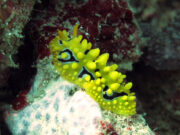
Phyllidiella ocellata @ Koh Haa
The body colour is highly variable, yellow, orange, brownish or even light grey, with several black and white ocellations (like eye spots on damselfish), which are sometimes connected.
There is considerable individual variation in dorsal patterns in this species, however the most typical dorsal pattern consists of four to ten black rings bordered in white, each with a central gold or white tubercle.
The large tubercles on the dorsum (upper back) are very obvious, and the rhinophores are orange-yellow.
Ceylon Phyllidiidae
(Phyllidiella zeylanica)
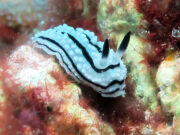
Phyllidiella zeylanica @ Koh Haa
The Ceylon Phyllidiidae has numerous ridges of tuberculate which curve to join anteriorly and posteriorly (but may be interrupted).
A single black band (sometimes not complete) encloses both the rhinophores and the anal orifice, and may contain several black markings within the central black ring. The anterior section of this black band is squared, a feature unique to this species.
The foot sole is pale, and the rhinophores are mostly black, with the lower 2 or 3 lamellae being white.
Varicose Wart Slug
(Phyllidia varicosa)
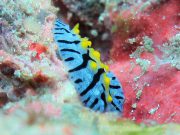
Phyllidia varicosa @ Koh Haa
Capable of changing colours and textures, the Varicose Wart Slug has a generally black under-colour with bluish speckled patches, lines, spots and blotches which contain the yellow and blue warts which can appear to be in rows. Has yellow rhinophores (sensory tentacles behind the head).
The Varicose Wart Slug grows to 7 cm and is a very poisonous species, using its toxins for defence, and has no known predators.
Elegant Sea Slug
(Phyllidia elegans)
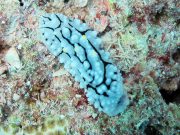
Phyllidia elegans @ Koh Haa
The Elegant Sea Slug has a pale coloured foot with a thin black line along the middle. The body warts (tubercles) are light pink, the larger often with yellow tips.
The light pinkish warts may look grey underwater due to loss of red light. The rhinophores (sensory tentacles on the head) often have pale yellow tips.
The Elegant Sea Slug grows to 6.5 cm, feeds solely on sponges and excretes powerful toxins when distressed.
Pimpled Phyllidiella
(Phyllidiella pustulosa)
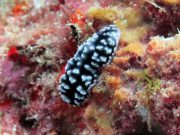
Phyllidiella pustulosa @ Koh Haa
The Pimpled Phyllidiella has a generally black body colour, with whitish to pinkish to greenish warts (tubercles) and black oral tentacles. The tubercles are usually grouped in clumps. The edge of the mantle is pale pink.
The black body colour forms a net-like pattern, rather than lines which are seen in other similar looking phyllid nudibranchs.
The Pimpled Phyllidiella grows to 6 cm and the body slightly elongate, rather than oval.
This species is highly poisonous.
Diving with Wart Slugs around Koh Lanta
Scuba Diving & Snorkel Trips
If you'd love a chance to spot Wart Slugs on one of our daily high season diving trips from Koh Lanta then send us an email to info@diveandrelax.com.
Join our high season speedboat dive trips to some of Thailand's best dive sites and enjoy small groups, short journey times, with a focus on great personal service, safety and fun.
Not yet a certified diver? Learn to Scuba Dive on Koh Lanta with the 3 day SSI Open Water Diver course.
Book online to save 10% on dive trips and scuba courses on Koh Lanta.
Find Out More
Indo-Pacific Marine Life Guides
- Allen, G., Steene, R., Humann, P., DeLoach, N. (2003) Reef Fish Identification, Tropical Pacific. Jacksonville, FL., USA: New World Publications, Inc., ISBN 1-878348-36-1.
- Humann, P., DeLoach, N., (2010) Reef Creature Identification, Tropical Pacific. Jacksonville, FL., USA: New World Publications Inc., ISBN 978-1-878348-44-9
- Debelius, H. (2013) Indian Ocean Reef Guide. Frankfurt, Germany: IKAN - Unterwasserarchiv, ISBN 978-3-939767-52-7.
- Debelius, H. (2004) Nudibranchs and Sea Snails, Indo-Pacific Field Guide. Frankfurt, Germany: IKAN - Unterwasserarchiv, ISBN 3-925919-51-1
- Erhardt, H., Knop, D. (2015) Corals Indo-Pacific Field Guide. Frankfurt, Germany: IKAN - Unterwasserarchiv, ISBN 3-925919-69-4.
- Veron J.E.N., Stafford-Smith M.G., Turak E. and DeVantier L.M. (2016). Corals of the World
